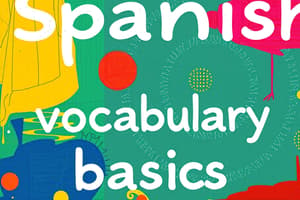Podcast
Questions and Answers
What is the Spanish translation for 'I am (temporary)'?
What is the Spanish translation for 'I am (temporary)'?
- Tú eres
- Yo estoy (correct)
- Tú estás
- Yo soy
Which number corresponds to 'cien' in Spanish?
Which number corresponds to 'cien' in Spanish?
- 100 (correct)
- 1000
- 10
- 15
How do you ask 'What time is it?' in Spanish?
How do you ask 'What time is it?' in Spanish?
- ¿Dónde vives?
- ¿Cómo estás?
- ¿Qué hora es? (correct)
- Son las tres menos cuarto
What does 'bonito/a' mean in English?
What does 'bonito/a' mean in English?
If it is 'Son las dos y media', what time is it?
If it is 'Son las dos y media', what time is it?
Study Notes
Numbers
- Basic Spanish numbers include "uno" for 1, "diez" for 10, "quince" for 15, "cien" for 100, and "mil" for 1000.
Adjectives
- Common adjectives in Spanish include "bonito (a)" which means pretty, "alto (a)" meaning tall, "rápido (a)" for fast, and "grande" meaning big.
Ser vs. Estar
- "Ser" is used for permanent states, e.g., "Yo soy" translates to "I am."
- "Estar" is used for temporary conditions, e.g., "Yo estoy" means "I am."
- "Tú eres" translates to "You are" (permanent) and "Tú estás" means "You are" (temporary).
Telling Time
- To ask the time in Spanish, use "¿Qué hora es?" which means "What time is it?"
- "Son las dos y media" indicates it's 2:30.
- "Son las tres menos cuarto" indicates it's 2:45.
Common Questions
- Frequently used questions include "¿Cómo estás?" which asks "How are you?"
- "¿Dónde vives?" translates to "Where do you live?"
- "¿Qué hora es?" is also used to ask for the time.
Studying That Suits You
Use AI to generate personalized quizzes and flashcards to suit your learning preferences.
Description
Test your knowledge of basic Spanish numbers, adjectives, and verbs. This quiz covers key concepts like 'ser' vs. 'estar', telling time, and common questions in Spanish. Perfect for beginners looking to improve their language skills.




